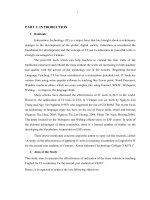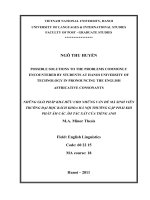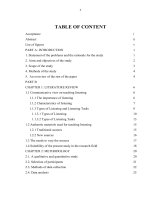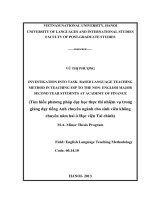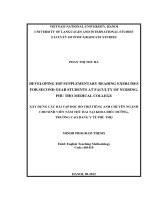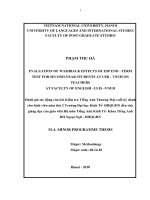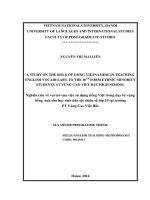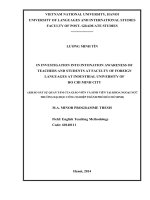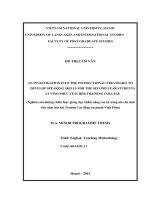Investigation into Task-based language teaching in teaching ESP to the non-English major 2nd year students at Academy of Finance
Bạn đang xem bản rút gọn của tài liệu. Xem và tải ngay bản đầy đủ của tài liệu tại đây (133.55 KB, 3 trang )
Investigation into Task-based language teaching
in teaching ESP to the non-English major 2nd
year students at Academy of Finance
Vũ Thị Phượng
Trường Đại học Ngoại ngữ
Luận văn Thạc sĩ ngành: English teaching methodology; Mã số: 60 14 10
Người hướng dẫn: M.A. Cao Thúy Hồng
Năm bảo vệ: 2012
Abstract. The researcher’s underlying aim in carrying out this research is to examine the
application of task- based language teaching method to teach ESP lessons. Once the
theoretical background for the study was finalized, the researcher began designing the data
collection instruments, which included two questionnaires, interview schemes and
observation. The overall result was that the tasks are used in ESP class to teach second-
year non- major students; various types of tasks are exploited in three stages of task cycle
(Pre- While- Post task). Besides, some suggestions for a better ESP lesson via tasks are
included in this study.
Keywords. Phương pháp giảng dạy; Tiếng Anh
Content
I. Statement of the problem and the rationale for the study
English is being taught as a foreign language in Vietnam from Elementary school. It is also
used as a medium of instruction in secondary and tertiary level of education. Although the students
have learnt English for a long time, they are unable to reach the expected proficiency level when
they start tertiary education. Over the years, different approaches, methods and procedures, have
been employed to help learners learn English. Some traditional methods are GTM (Grammar
Translation method), ALM (Audio Lingual method). These methods are teacher- center, and focus
on linguistic accuracy rather than interactive or communicative competence of learners. Learners are
often passive in class and have difficulties communicating in the real life. Since the late 20
th
century,
along with globalization trends, the demand for English as a global language in international
business, travelling and cultural exchange etc has becoming higher and higher. As a result,
nowadays, a new method of teaching and learning English to serve those purposes has been indeed
indispensable, and learner-centered approaches have been developed. The new approaches draw
knowledge from the learner, working through their needs and interests and selecting materials,
activities and tasks accordingly. One modern method is Communicative Language Teaching (CLT).
According to Richards and Rodgers (2001), CLT is the acquisition of communicative competence
via student engagement in meaningful use of language at discourse level. To achieve this, the teacher
facilitates communicative activities by managing the classroom environment, providing resources
and acting as a communicator. “Classroom activities are often designed to focus on completing tasks
that are mediated through language or involve negotiation of information and information sharing”
(Richards and Rodgers 2001: 165). One of the most popular methods within CLT recently is task-
based language teaching (TBLT). This method promotes communication and social interaction. In
this method, learners are presented with a task or problem to solve and do not concentrate on
language features during performance. Language analysis is incorporated after learners have
performed a task.
TBLT focuses on using the tasks which are suitable for or meet students’ needs. The reasons
are TBLT seems to bring meaningful use of language with authentic tasks and it can promote
autonomous learning. With such advantages, it has been applied into many English courses. There is
no exception of TBLT application to English for Specific Purposes (ESP) courses in which the
requirements are the knowledge of specialization and skills of English to achieve the goal of
professional communication in professional fields. Therefore, both ESP and task- based language
teaching method focus on learners’ needs to reach a certain goal and obviously, the exploitation of
TBLT in ESP teaching is a good choice for many ESP teachers.
In fact, there have been some studies on application of TBLT in ESP so far in many countries
including Vietnam , yet they only focused on certain aspects such as effectiveness, syllabus design
etc. Students and teachers, the two key factors of any teaching and learning, have not been
sufficiently studied. In Academy of Finance, ESP is an obligatory subject in 2 semesters for second-
year students and third- year students and ESP teachers here have applied TBLT for their lessons.
This inspired the researcher to conduct a research on the perceptions of teachers and learners of
TBLT in ESP here.
II. Aims and objectives of the study
In the first place, this study aims to identify teachers and students’ perceptions of TBLT in
ESP. Specifically, the study would investigate into how teachers and students think or feel about the
task and features of TBLT in ESP course. Secondly, a closer look is taken to find out how tasks are
realized in ESP class. In other words, the researcher tries to investigate how often TBLT is exploited
for second- year students in ESP course, which type of task is preferred in ESP class, and how task
steps are realized in class. In addition, some pedagogical techniques to overcome the problems or
disadvantages will be provided as suggestions for TBLT application in the same context.
In brief, the researcher expects to answer three following questions:
1. What are teachers and students’ perceptions of TBLT in ESP?
2. How is TBLT realized in ESP class?
3. What are teachers and students’ suggestions for TBLT to teach ESP course?
III. Scope of the study
First, although TBLT is generally set as the title of the whole study, it is impossible for the
researcher to cover everything related to TBLT but only some aspects of the issue in the given
context. This research only focuses on the context of ESP course in AOF for non- major second-
year students. Secondly, the research is done to find out the perceptions of teachers and students in
terms of concept, features, task realization and disadvantages of TBLT. Thirdly, it is noteworthy that
the sample of the research is restricted to 60 students and 10 teachers in Faculty of Foreign
languages in AOF.
IV. An overview of the rest of the paper
The rest of the paper includes 2 parts as follows:
Part B: Development
Chapter 1 – Theoretical Background and Literature review – provides the background of the study,
including definitions of key concepts, discussions of related studies and how the present study fits
into the field.
Chapter 2 – Methodology – describes the participants and instruments of the study, as well as the
procedure employed to carry out the research.
Chapter 3 – Data analysis and discussion – presents, analyzes and discusses the findings that the
researcher found out from the data collected according to the three research questions.
Part C: Conclusion
This part summarizes the main issues discussed in the paper, the contribution as well as the
limitations of the research, suggestions for successful TBLT application in ESP course and some
suggestions for further studies. Following this chapter are the References and Appendices.
References
1. Abdullah, S & Leila, F. S (2012), “The Impact of Task-based Approach on Vocabulary
Learning in ESP”, English Language Teaching, 5 (10).
2. Dudley- Evan, T & M, S St John, (1988), Developments of English for Specific Purposes,
Cambridge University Press.
3. Ellis, R. (2003), Task-based language learning and teaching, Oxford University Press,
Oxford.
4. Ellis, R (2006), “The Methodology of Task-Based Teaching”, Asian EFL Journal, 8 (3).
Retrieved January 9, 2009, from
5. Hutchison, T & A. Waters, (1987), English for Specific Purpose- A learning- centered
approach, Cambridge University Press.
6. Gatehouse, K, (2001), Key Issues in English for Specific Purposes (ESP)eCurriculum
Development. Retrieved from
7. Kavaliauskienė, G (2005), “Task-Based Learning and Learning Outcomes in the ESP
Classroom”, Studies about languages, 7.
8. Liên, V.T, (2011), Designing a task-based ESP reading syllabus for the third-year students
at Hai Duong Central College of Pharmacy, MA thesis, ULIS, VNU, Hanoi.
9. Littlewood, W (1993), Task- based language learning of Grammar, In N. Bird, J.Harris and
M. Ingham (eds.): Language and Content, Hong Kong Institute of Language in Education.
10. Long, M. H, & G. Crookes (1992), “Three Approaches to task- based syllabus design”,
TESOL Quarterly, 26 (1), pp. 27- 56.
11. Nunan, D (2004), Task- based language teaching, Cambridge University Press, Cambridge.
12. Prabhu, N. S. (1987), Second language pedagogy, Oxford University Press, Oxford.
13. Patricia, C. C (2009), “Using task- based instruction in an ESP course in the computer centre
at the University of Costa Rica”, English language teaching, 9 (1), pp. 1-25 retrieved from
website abcde
14. Richards, J. C., & Rodgers, T. S. (2001), Approaches and methods in languageeteaching,
Cambridge University Press, Cambridge.
15. Robinson, P. C, (1991), ESP Today: A Practitioner's Guide, Helmet Press.
16. Skehan, P. (1998), A Cognitive Approach to Language Learning, Oxford University Press,
Oxford.
17. Strevans, P (1988), ESP after twenty years: A re- appraisal, SEAMEO regional centre,
Singapore.
18. Willis, D., & Willis, J. (2007). Doing task-based teaching. Oxford: Oxford University press.
19. Willis, J. (1996) A Framework for Task-Based Learning. Longman.
